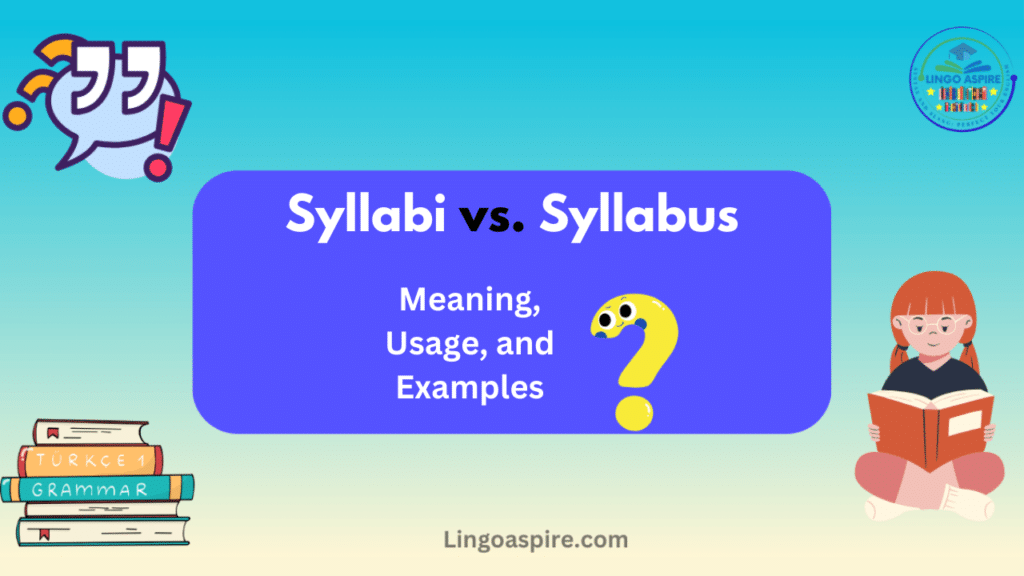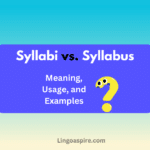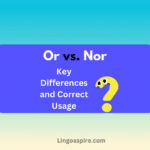Syllabi vs. Syllabus often confuses students, teachers, and even native English speakers. Both words connect to education, but understanding their proper use helps you sound more professional. A syllabus is a document that outlines everything a student needs to know about a course. It includes topics, deadlines, grading rules, and reading lists. Every class, from school to university, usually begins with a syllabus.
Now, when there’s more than one syllabus, people get stuck. Should you say syllabi or syllabuses? The answer is—both are correct. The word syllabus comes from Latin, which is why the plural syllabi sound scholarly and formal. However, syllabuses are the standard English plural form. You might hear both in different places, but which one you choose depends on the audience and setting.
In formal writing or academic discussions, syllabi sound more refined. But in everyday conversations or casual articles, syllabuses feel more natural. Knowing the difference makes your writing clear and helps you avoid common mistakes. This guide explores the meanings, origins, correct usage, and examples of Syllabi vs. Syllabus so you never feel confused again. By the end, you’ll easily choose the right word, impress your audience, and write with confidence.
What is a Syllabus? Meaning and Purpose Explained

A syllabus is a document that outlines everything a student needs to know about a course. Teachers, professors, or instructors create it before classes start. You can think of it as a roadmap for students. It helps them understand what to expect, what they’ll learn, and how they’ll be graded. A syllabus often includes key information like the course title, instructor’s name, class schedule, grading policies, reading lists, and assignments. It acts as a contract between the teacher and students.
In many schools, colleges, and universities, the syllabus is mandatory. It gives students an overview of the course and saves time for teachers. Instead of answering the same questions again and again, instructors put all necessary details in one place. A clear syllabus improves learning because it sets expectations. Students know when assignments are due, what topics they’ll cover, and how tests will be conducted. According to experts, a well-written syllabus reduces confusion and makes learning smooth. Many academic institutions now use digital syllabi to make updates easier.
Syllabus and Its Plural: Syllabi vs. Syllabus
The word syllabus comes from the Latin language. Historians believe it was a printing mistake in old Latin texts. The correct term should have been “sittybas,” which meant a label or list. Over time, “syllabus” became popular in English, especially in the education system. But what happens when you need to talk about more than one syllabus? That’s where most people get confused. Should you say syllabi or syllabuses?
Both forms are correct. Syllabi is the Latin plural, while syllabuses is the regular English plural. Grammarians explain that when English borrows words from Latin, sometimes both the original Latin plural and the new English version become acceptable. Words like fungus/fungi and radius/radii follow the same rule. English is flexible, and it changes with time. Many teachers, scholars, and grammar guides agree that both syllabi and syllabuses are valid. Some people believe syllabi sound more academic or formal, while syllabuses is easier and more common in daily conversations.
In American English, you’ll see syllabuses used more often in schools and colleges. It feels simpler and natural. British English users may lean towards syllabi because of its classic feel. Still, both versions appear in respected dictionaries like Merriam-Webster and Oxford. Neither form is wrong, so the choice depends on the tone you want to set.
Table: Usage Comparison of Syllabi vs. Syllabus
| Word | Usage Context | Example Sentence |
|---|---|---|
| Syllabi | Formal, academic writing | “All course syllabi must be submitted by next week.” |
| Syllabuses | Casual speech, general writing | “The school updated the syllabuses for next term.” |
How to Use Syllabi and Syllabuses Correctly?
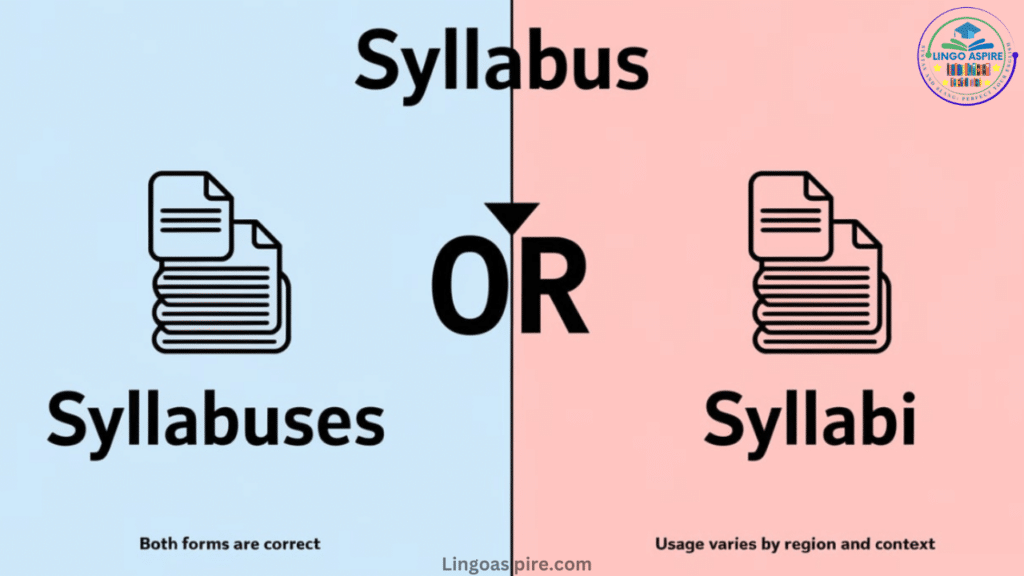
Choosing between syllabi and syllabuses often depends on your audience. If you’re writing a research paper, academic report, or anything scholarly, using syllabi might sound more appropriate. It shows you understand the word’s classical roots. However, if you’re talking casually, writing an email, or preparing content for general readers, syllabuses feels easier to read and understand.
For example, universities may state, “Submit all course syllabi by Friday.” Meanwhile, a school newsletter might say, “New syllabuses for Grade 10 will be ready soon.” Both are correct, and neither choice will confuse readers. The only thing that matters is consistency. Once you pick one version, stick with it throughout your writing to maintain clarity. Grammar experts recommend focusing more on readability than following strict Latin rules.
There’s also a growing trend in digital learning platforms where syllabuses appears more frequently. Since online learners prefer simpler language, websites and e-learning portals avoid complex Latin words. Instructors uploading materials for massive open online courses (MOOCs) also favor syllabuses. This change reflects how modern English keeps evolving to stay user-friendly.
Why Does This Plural Matter in Academic and Professional Writing?
Understanding the correct plural of syllabus helps maintain professionalism. Imagine writing to a university board or applying for an academic job. If your grammar is off, it might lower your credibility. Using the correct form also shows respect for academic traditions. It proves that you pay attention to small details, which often matter the most in scholarly work.
Some people argue that using syllabi in professional writing creates a formal tone. It fits naturally in research papers, thesis documents, and education journals. On the other hand, many corporate training programs or online courses prefer syllabuses because it’s direct and less formal. Business English often avoids unnecessary complexity, making syllabuses the preferred choice.
Case studies from educational institutes reveal that older universities still favor syllabi, while newer colleges and schools are shifting towards syllabuses. A review of popular educational websites shows this trend clearly. For instance, Harvard University often uses syllabi, while Coursera or Udemy stick with syllabuses to connect better with a global audience.
Common Mistakes and Misconceptions About Syllabus Plurals
Many people mistakenly believe that only syllabi is correct. This myth probably comes from the idea that Latin forms are superior in academic settings. However, grammar guides clarify that English often allows both traditional and modern forms. It’s not wrong to say syllabuses because it follows normal English grammar rules. Just like we say buses instead of busi or focuses instead of foci in daily speech, syllabuses works perfectly fine.
Another mistake is assuming that one form is American and the other is British. While syllabi might sound British, there’s no strict rule about regional usage. Both versions appear in American and British English. Some students even try to mix them in one sentence, which creates confusion. The best advice is to pick one form based on your audience and stick to it.
A surprising fact is that most spell-check tools accept both forms. Google search trends also show that people search for syllabi when looking for academic resources, but syllabuses gets more hits on general education sites. This proves that both forms are common, and understanding their usage helps you write better.
Table: Misconceptions vs. Facts About the Word “Syllabus”
| Misconception | Reality |
|---|---|
| Only “syllabi” is correct | Both “syllabi” and “syllabuses” are accepted |
| “Syllabuses” is informal or wrong | “Syllabuses” is standard English and widely used |
| One is British, the other is American | Both are used in British and American English |
| Mixing both forms is okay | Consistency is important; choose one form per document |
When to Use Syllabi or Syllabuses: Practical Tips for Students and Professionals
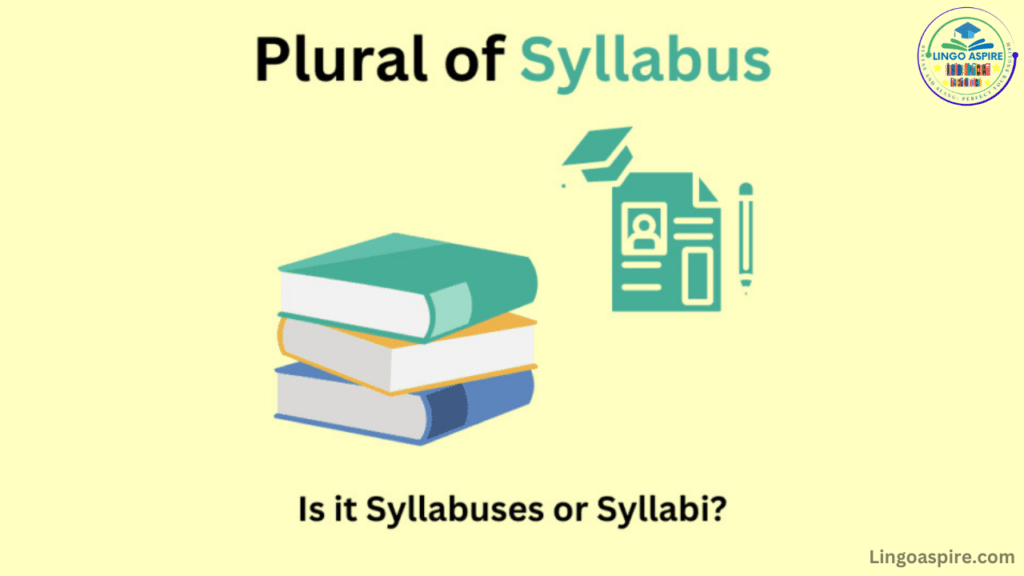
Writing well means knowing your audience. If you’re working on a thesis, dissertation, or official university document, using syllabi might give your writing a polished feel. It shows you respect academic traditions. But if you’re preparing a presentation, corporate training manual, or writing a blog post, syllabuses sounds less stiff and easier to understand.
Educational consultants often say that being clear is better than being technically perfect. For instance, students might feel confused if you use syllabi in a school handout meant for parents. In this case, syllabuses works better. Many teachers believe that the simpler the language, the better the engagement. After all, the main job of a syllabus is to inform, not confuse.
Famous grammarian Bryan Garner says, “When clarity is the goal, plain English wins every time.” So, if you’re unsure, choose syllabuses. It keeps your writing accessible to a wider audience, especially when writing online content.
Syllabi vs. Syllabus in Real-Life Contexts and Case Studies
Let’s look at how different institutions and platforms handle this plural. Oxford University prefers syllabi in its official documents. Their course descriptions often read, “Refer to the department’s syllabi for detailed modules.” This style matches their rich academic heritage.
Meanwhile, platforms like Coursera, EdX, and Skillshare avoid Latin complexity. They use syllabuses when describing course structures. For example, Coursera writes, “Check the updated syllabuses for each module.” This simple approach works better for international learners who may not be familiar with Latin plurals.
Another case is corporate training programs. Companies like Microsoft or Google use syllabuses in their employee manuals. It’s clear, modern, and professional. No one in the business world wants to stop and think about the Latin origin of a word during a busy day.
A survey of English teachers shows mixed preferences. Older educators lean towards syllabi, calling it traditional. Younger teachers argue that syllabuses fits modern classrooms better. This difference proves that language evolves, and so do teaching styles.
FAQs About Syllabi vs. Syllabus
1. What is the correct plural form: Syllabi or Syllabuses?
Both syllabi and syllabuses are correct. Syllabi follows the Latin plural, while syllabuses is the standard English form.
2. When should I use Syllabi instead of Syllabuses?
Use syllabi in formal, academic, or scholarly writing. Choose syllabuses for casual conversations, blogs, and general communication.
3. Is Syllabus the same as a Course Outline?
Yes, a syllabus often works as a course outline, listing topics, assignments, grading policies, and important deadlines.
Final Thoughts
The debate between syllabi and syllabuses has no strict winner. Both are correct, and the choice depends on what you’re writing and who your readers are. If you’re working in a formal academic setting, syllabi might feel right. But for general writing, online content, or casual speech, syllabuses sounds natural and easy.
Remember, the goal of any syllabus is to guide students, not to showcase Latin skills. Consistency matters more than anything else. Stick to one version throughout your writing, and you’ll sound professional and clear.
With the rise of digital learning, user-friendly language is becoming the norm. It wouldn’t be surprising if syllabuses completely overtakes syllabi in the coming years. After all, English is always changing, and simplicity often wins.
If you’re still unsure, follow this simple rule: When in doubt, choose syllabuses. It keeps your message simple, your audience engaged, and your writing free from unnecessary complexity.
Sources
- Merriam-Webster Dictionary – Definition and plural usage of syllabus
- Oxford English Dictionary – Historical origin and meaning of syllabus and syllabi
- Grammarly Blog – Guide on Latin plurals in English, including syllabi vs. syllabuses

